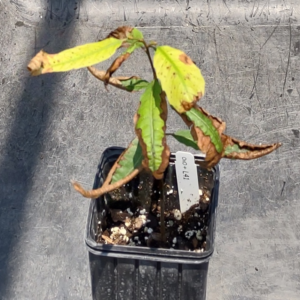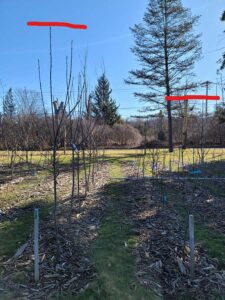by Anne Petermann of Global Justice Ecology Project
Late on Friday, December 8th, the American Chestnut Foundation (TACF) announced they were withdrawing their support for the “Darling 58” (D58) genetically engineered American chestnut tree.
After 10+ years and millions of dollars invested into the D58 chestnut, as well as a massive publicity campaign involving media outlets like the New York Times, Wall Street Journal, Washington Post and National Geographic, TACF had emerged as key players in the effort to restore the “majestic, mighty and iconic” American chestnut tree using the genetically engineered D58 variety.
As recently as August 2023, TACF was promoting the D58 as a “revolutionary transgenic American chestnut tree with enhanced blight tolerance” for use in “restoration” of the species.
Restoring Forests with Defective GE Trees
TACF was closely partnered in this effort with the State University of New York College of Environmental Science and Forestry (SUNY-ESF)’s American Chestnut Research & Restoration Project. SUNY-ESF was genetically transforming the trees, while TACF was readying and testing them for release into forests. The stated goal was to rescue the American chestnut the fungal blight but the unstated goal of this alliance was to transform our wild forests into a laboratory for their unpredictable and irreversible GE tree experiments. They would start with the GE chestnut, but move on to eventually include GE ash, elm and other trees, under the guise of “forest restoration”.

But, as some of us had predicted, the GE chestnuts that TACF was experimenting with were defective. As recorded on the TACF website, their growth is stunted, their leaves go brown and the engineered trait malfunctions, leading to high rates of mortality even in the absence of the blight fungus. When tested for blight resistance the effectiveness of the added transgene was poor. SUNY-ESF and TACF researchers first revealed all this to the public in a TACF webinar known as a “Chestnut Chat” on September 15, 2023.
SUNY-ESF submitted a petition to the USDA Animal Plant Health Inspection Service (APHIS) back in January 2020 requesting that their D58 GE trees, at that time seedlings that had only been growing in outdoor field trials for 3 years, be approved for unregulated release into forests.
Had USDA already rubber stamped this request, as they often do, those defective trees would by now be out in the forests wreaking havoc and threatening the viability of remaining wild American chestnut populations through contamination of the gene pool with their faulty pollen and nuts.
So what exactly happened?
In the September “Chestnut Chat”, it was revealed that the Darling 58 trees had an unexpectedly high mortality rate. They were growing 20% slower than their wild cousins and were susceptible to the blight they were engineered to resist. Even with this new information, however, TACF researchers stated in the Chestnut Chat that they still wanted APHIS to deregulate the D58. They wanted deregulation so they could do research with the faulty GE chestnuts in wild forest conditions, and crucially so they could set a regulatory precedent that would streamline future approvals of other GE chestnuts: “in the future, the regulatory reviews … are going to be a lot easier … in some cases it might be entirely exempt from regulation from one or more of the agencies.”

At the same time, the Chestnut Chat admitted that the regulatory agencies involved don’t even know how to regulate a genetically engineered forest tree: “…a wild tree that we hope can be planted in the forest and left and cross with wild relatives eventually, that’s such a fundamentally new thing for these agencies to deal with that that’s a lot of what we’re seeing is the agencies figuring out how to deal with this.”
Now that TACF has revealed that their signature project to breed blight resistant GE American chestnuts has failed, they are backpedaling after years of overpromising to the media, their members and the public about the potential of the D58 to restore the “majestic” American chestnut. As late as this Fall, long after TACF had begun noting significant problems with the D58 chestnut tree, the New York Chapter of TACF was promising its members access to the trees, “ESF has Darling 58 seedlings ready to distribute to our long-time members once we have permission.”
It was not until the September Chestnut Chat that the national TACF finally admitted to their membership that, after years of assurances and huge fundraising campaigns, TACF would not be distributing the D58 trees to the public. This decision was made, they said, not because the D58 trees were defective, but because they didn’t have enough of them and needed them for research. “Even after we get approval, we won’t have enough seedlings to use for all the purposes that they need to be used for and to give to everyone who wants one…”
In their surprise press release announcing the withdrawal of support for the SUNY-ESF petition to deregulate the D58 GE chestnut, TACF’s Chief Conservation Officer Sara Fitzsimmons stated that the TACF decision to pull out was not due to the dangers of releasing defective, GE tree to wild forests to contaminate wild trees, but a public relations question, “Premature distribution of this or other inferior varieties may unfairly skew public perception against biotechnology solutions to save threatened forest tree species.”
SUNY-ESF and the “wrong” GE Tree
Another wild turn of events in the D58 chestnut saga occurred when TACF revealed in their December 8th press release that the genetically engineered D58 tree they had been propagating was not, in fact, a D58 tree at all. Somehow, SUNY-ESF had given TACF the wrong pollen and trees as early as 2016. TACF was given Darling 54 trees, not D58 trees – which are a different GE tree variant. “Within the past few weeks, academic colleagues brought to our attention their newest findings suggesting a significant identity error in the propagation materials supplied to TACF. Independent confirmation now shows all pollen and trees used for this research was derived not from Darling 58, but from a different prototype…”
It was the completely wrong genetically engineered tree, yet American Chestnut Foundation scientists did not notice for seven years.
So where is SUNY-ESF and their American Chestnut Research & Restoration Project in all of this? They are doubling down. A public statement appeared on Facebook, just hours after the TACF announcement on December 8. Apparently, the mixup also affected their own trials:
“Extensive testing has been done on Darling 54. The difference between Darling 54 and Darling 58 is the location of the new transgenes; the OxO gene is the same but located on a different chromosome. Data we have already provided to regulatory agencies confirms safety and characteristics of D54.”
From the tone of the statements, ESF and TACF have called up divorce lawyers. ESF is ignoring TACF’s assertions about the disastrous GE tree mix up, and are solidly standing behind their science, still hoping to get their D58 deregulated by APHIS. In a statement geared to donors, Brenda Greenfield, Executive Director of the ESF College Foundation states:
“Dear Donor, You may have heard that the American Chestnut Foundation (TACF) is no longer supporting trees developed by the American Chestnut Research and Restoration Project at ESF. We are disappointed that they are withdrawing from our longstanding partnership, but it in no way impacts the continued research at ESF … as a donor, we wanted you to be among the first to know that ESF remains committed to chestnut and tree restoration research. We are continuing to pursue approval from federal agencies and have no indication that TACF’s position will derail that process.”
Lucy Sharratt, Coordinator of the Canadian Biotechnology Action Network (CBAN) calls for accountability:
“[SUNY-ESF] now has a responsibility to withdraw its request for approval. This genetically engineered tree has been found to be useless a full three years after developers asked the US government to approve its release. The developers rushed this GE tree forward based on assumptions and hope rather than science and testing.”
End the Experiment with Our Forests
Genetically engineering trees is a disaster waiting to happen. Releasing them into wild forests opens a Pandora’s Box of irreversible problems that may not be known for decades. Global Justice Ecology Project and the Campaign to STOP GE Trees, along with allies like the Center for Food Safety, Canadian Biotechnology Action Network, Indigenous Environmental Network, Biofuelwatch and a litany of others have been warning of the risks for years, and when the petition to deregulate went to APHIS, these groups rallied thousands of people to register their opposition to this “massive irreversible experiment” with our forests.
Our fears very nearly came true – and still could if ESF does not drop its petition to the USDA. The multiple defects of the Darling lines prove that the DNA of wild forest trees is not like a computer program. Genomes cannot be edited or manipulated at will without risking serious unpredictable consequences.
On top of it all is the important fact that blight-tolerant American chestnuts are already on their way back. The American Chestnut Cooperators Foundation and others have been working for decades to breed wild American chestnuts that show levels of tolerance to the blight, with notable success. The scheme to release GE chestnuts into forests actually threatens to derail these efforts and instead may cause the ultimate loss of the wild American chestnut tree.
The only rational choice for genetically engineered trees is to prohibit them from ever being allowed outside of the laboratory. GE trees should be banned.
If this article was useful to you please consider sharing it with your networks.



About time.
I have been growing American Chestnuts for 40 years with no backcrossing and no GMO. My breeding has been along the same lines as ACCF. WE expose them to the blight and next generation progeny do show some resistance. The GE/GMO method is polluting the genome.
See my internet site at KB’s All Natural American Chestnuts.
Thanks
bless you